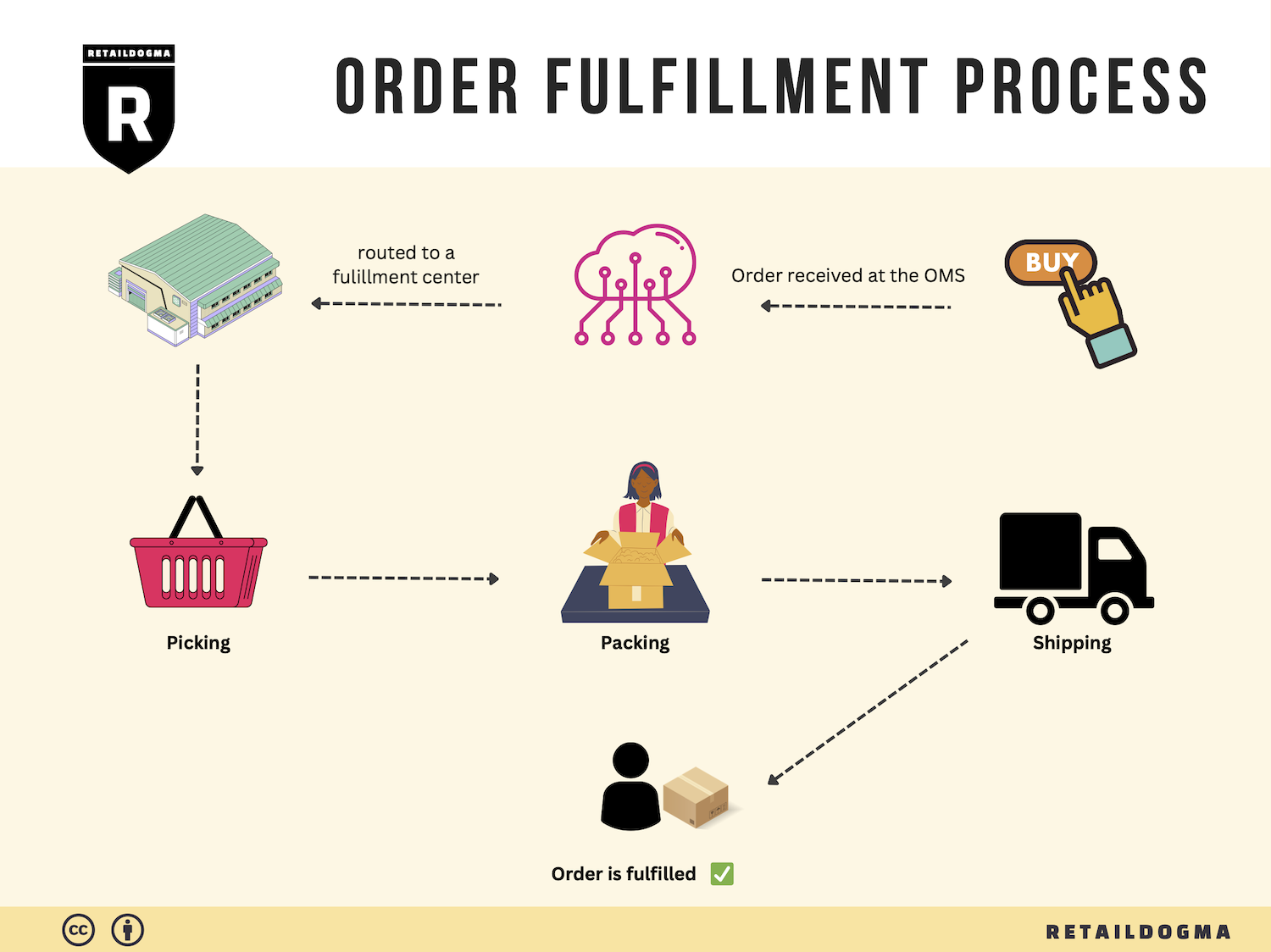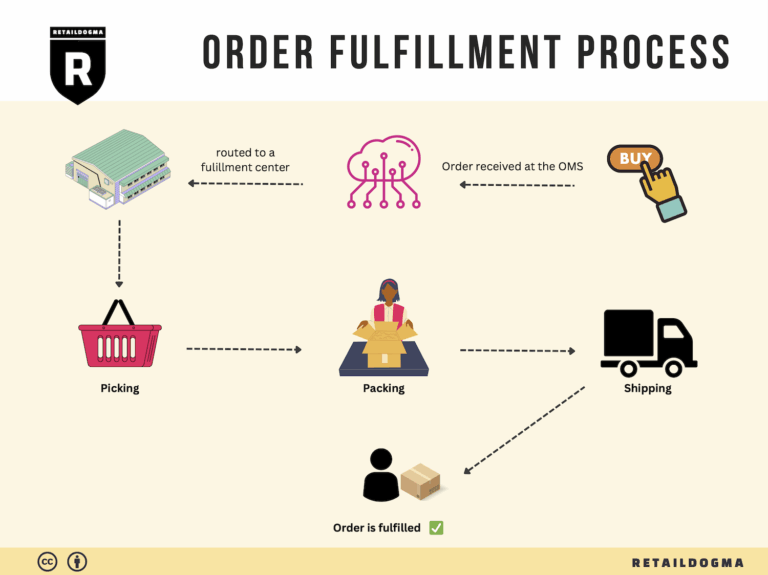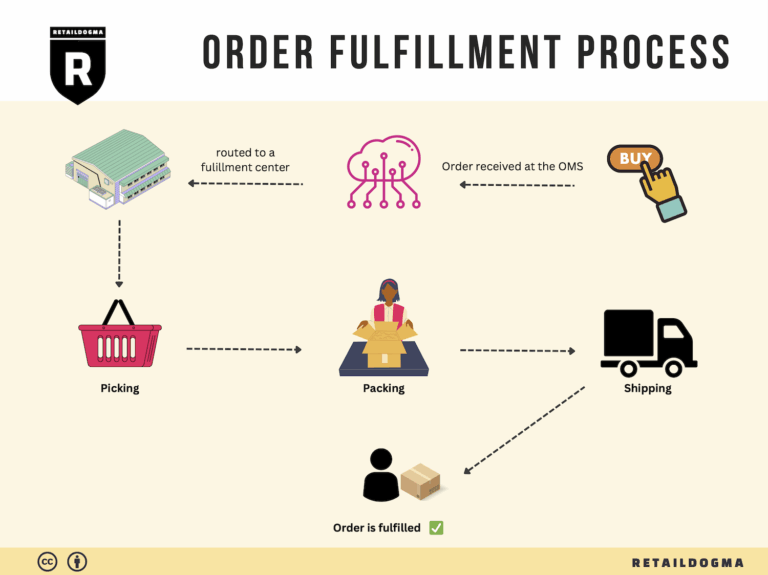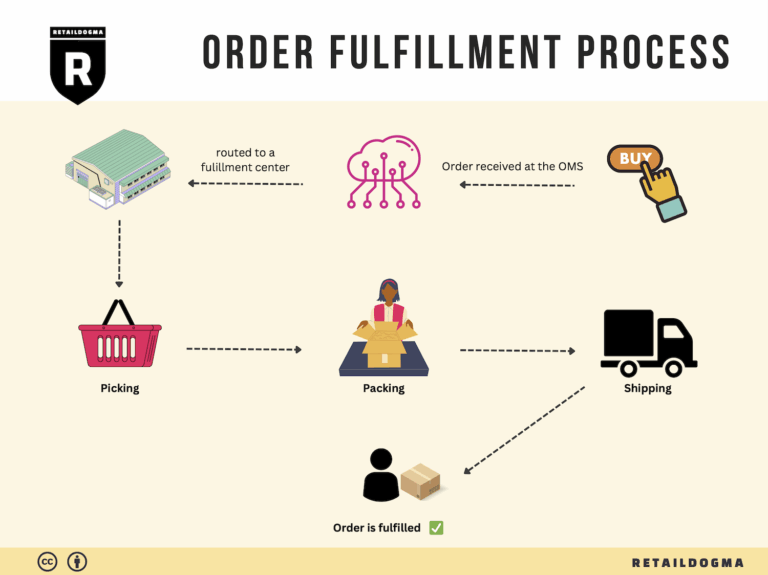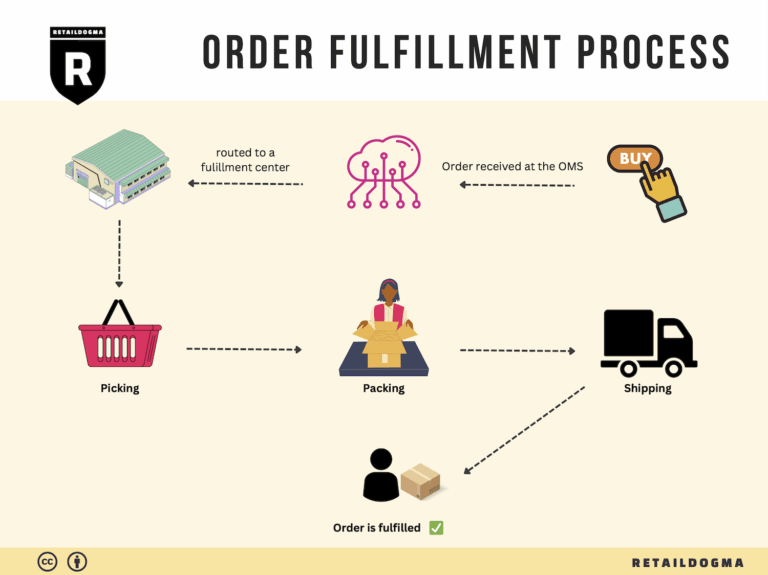What Is A Fulfillment Center? A Complete Guide (2025)
What is E-commerce Fulfillment? An Introduction for Growing Businesses
Understanding the Challenges of E-commerce Fulfillment
As an e-commerce business owner, you may have experienced the overwhelming burden of packing and shipping orders. The excitement of growing sales can quickly turn into chaos when you’re juggling inventory, logistics, and customer expectations. This pressure is a common pain point for many online retailers, especially those scaling their operations. Without a streamlined fulfillment process, your business can face delays, increased costs, and dissatisfied customers, ultimately affecting your bottom line.
Defining E-commerce Fulfillment
At its core, e-commerce fulfillment is the process of getting a product from your warehouse or fulfillment center to the customer’s doorstep. This involves various critical steps, including receiving inventory, storing products, picking and packing orders, and managing returns. When executed efficiently, e-commerce fulfillment can significantly enhance customer satisfaction, improve operational efficiency, and support business growth.
What This Guide Will Cover
In this comprehensive guide, we will explore several key aspects of e-commerce fulfillment that are essential for growing businesses:
-
Fulfillment Models: We’ll break down different fulfillment options, including third-party logistics (3PL) and Fulfilled by Amazon (FBA), helping you understand which model aligns best with your business needs.
-
Core Services: Discover the fundamental services involved in e-commerce fulfillment, from warehousing and inventory management to shipping and returns processing.
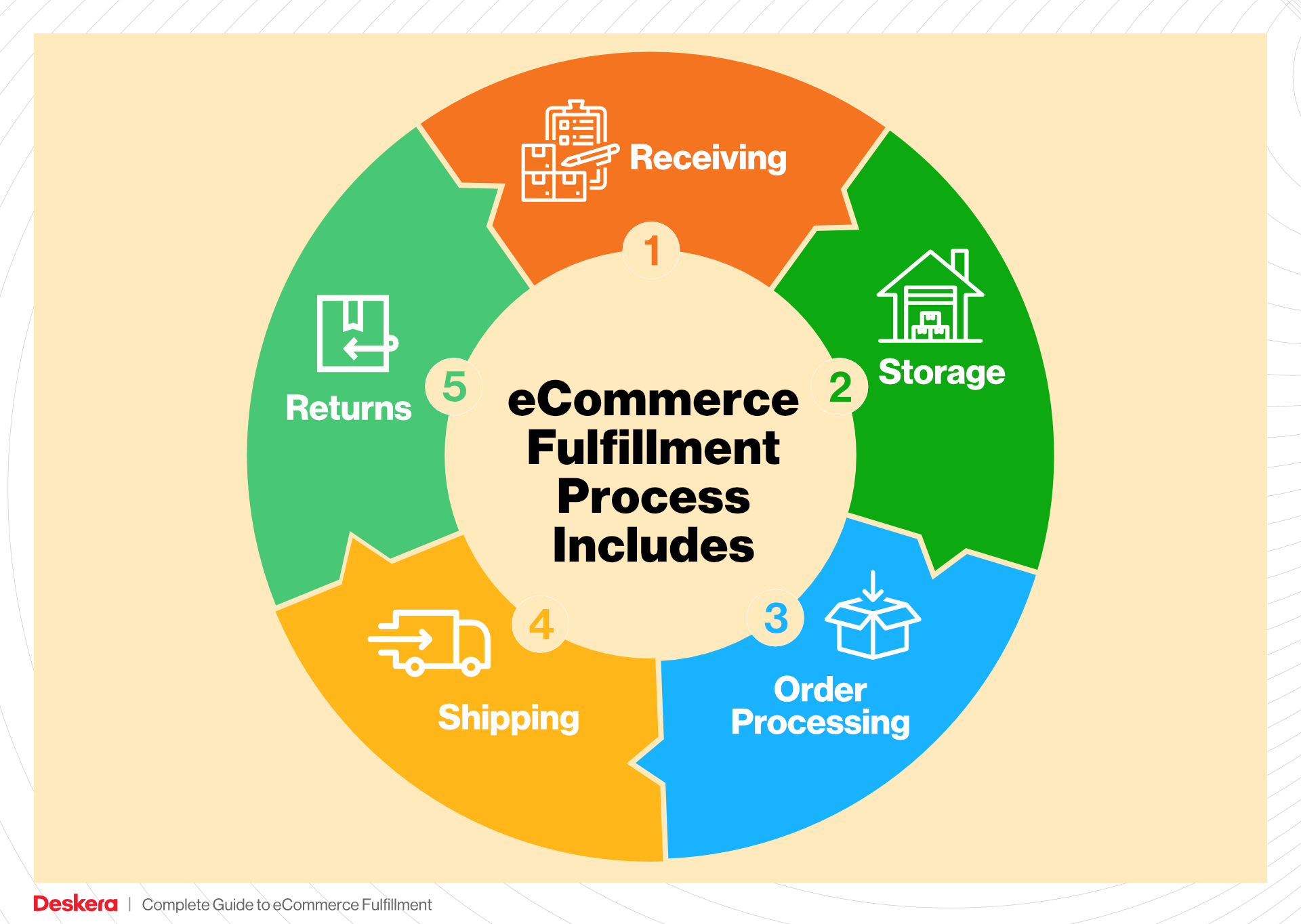
-
Choosing the Right Partner: Learn how to evaluate potential fulfillment partners, including what questions to ask and key factors to consider to ensure they align with your business goals.
-
Pricing Considerations: We’ll provide insights on how fulfillment pricing works, what to expect, and how to budget effectively for these essential logistics services.
Empowering Your Business Decisions
Our goal with this guide is to empower you to make informed decisions about your logistics strategy. Understanding e-commerce fulfillment is crucial for scaling your operations, reducing costs, and enhancing customer satisfaction. By leveraging the right fulfillment strategies and partners, you can focus on what you do best—growing your business and serving your customers. Let’s dive into the details that will help you navigate this critical aspect of e-commerce operations successfully.
What You’ll Learn In This Guide
- What is E-commerce Fulfillment? An Introduction for Growing Businesses
- The Order Fulfillment Process: From ‘Buy’ Button to Customer’s Door
- Comparing Fulfillment Models: In-House vs. 3PL vs. Dropshipping
- A Deep Dive into Amazon FBA: Pros, Cons, and Who It’s For
- Core Services Offered by Fulfillment Centers
- How to Choose a Fulfillment Partner: A 6-Point Checklist
- Understanding Fulfillment Pricing: A Breakdown of Common Fees
- Frequently Asked Questions (FAQs) about Fulfillment
- Conclusion: Is Outsourcing Fulfillment the Right Move for Your Business?
- Important Disclaimer
The Order Fulfillment Process: From ‘Buy’ Button to Customer’s Door
1. Receiving Inventory
The order fulfillment process begins with receiving inventory at the fulfillment center. When products arrive, they are unloaded from delivery trucks into designated receiving bays. It’s crucial to provide an Advance Shipping Notice (ASN) to the warehouse, detailing the shipment’s contents and expected arrival time. This preparation allows warehouse staff to be ready to log the items into the Warehouse Management System (WMS) efficiently.
Receiving is significant because it sets the foundation for inventory accuracy. A thorough inbound process helps identify damaged goods or discrepancies in SKUs (Stock Keeping Units) right away, preventing future issues in order fulfillment. The speed at which inventory is entered into the WMS is also vital; ideally, this should happen within one to two days of receipt. Efficient receiving processes not only enhance inventory management but also improve overall operational efficiency, enabling businesses to capitalize on sales opportunities without delays.
2. Warehouse Storage
Once inventory is received and logged, the next step is effective warehouse storage. Proper organization within the warehouse is essential for facilitating quick order fulfillment. Products are strategically placed on shelves based on various factors, such as sales volume and item type. For instance, high-demand items are stored closer to packing stations, minimizing the distance pickers must travel.
The importance of organized storage cannot be overstated. A well-structured warehouse leads to faster picking times and reduces the chances of fulfillment errors. Common storage methods include zone picking, where each picker is assigned a specific area of the warehouse to streamline operations. Additionally, maintaining accurate inventory levels through effective stock management ensures that businesses can meet customer demand without overstocking, which can tie up cash flow.
3. Order Picking
When a customer places an order, the fulfillment process transitions to order picking. The WMS generates a pick list that outlines the items needed to fulfill the order, including their specific locations within the warehouse. Pickers then utilize this list to gather the required items from the shelves.
Order picking is a critical step because the speed and accuracy of this process directly impact customer satisfaction. Delays in picking can lead to longer shipping times, which can frustrate customers and harm your brand’s reputation. Various picking methods exist, such as batch picking (where multiple orders are picked simultaneously) or single order picking (where one order is fulfilled at a time). Each method has its advantages, and businesses should choose based on their specific volume and operational capabilities.
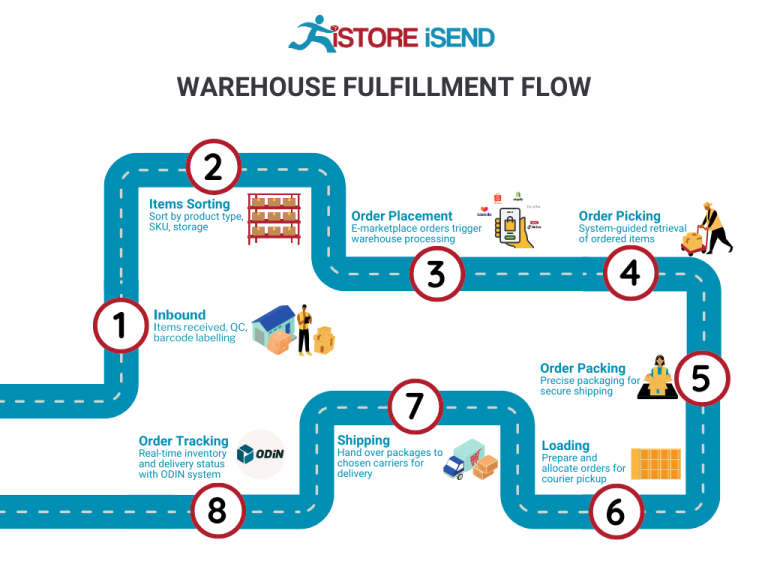
4. Order Packing
After items are picked, they are brought to the packing station for preparation for shipment. In this step, packers secure the products in appropriately sized boxes, using infill materials to prevent movement during transit. They also apply shipping labels and packing slips to ensure that the correct items reach the customer.
Packing is essential for several reasons. First, it protects the products during transit, reducing the likelihood of damage and returns. Second, efficient packing can significantly influence shipping costs; using the right box size minimizes shipping fees. Best practices suggest that orders should be packed and shipped the same day they are received to meet customer expectations for fast delivery. Timely packing helps enhance the overall customer experience and fosters loyalty.
5. Shipping & Delivery
The final step in the order fulfillment process is shipping and delivery. Once the order is packed, it is transferred to the outbound dock, where shipping staff check the shipping labels and organize packages for carriers such as UPS, FedEx, or USPS. Choosing the right shipping method is crucial for meeting customer expectations regarding delivery speed and cost.
Shipping is pivotal because it represents the culmination of the entire fulfillment process. Delays or errors at this stage can lead to dissatisfied customers and increased return rates. To optimize shipping efficiency, businesses should consider their warehouse locations, as strategically placed warehouses can reduce shipping times and costs. Additionally, offering multiple shipping options allows customers to select their preferred delivery method, further enhancing their shopping experience.
In summary, understanding and optimizing each step of the order fulfillment process is essential for e-commerce success. By focusing on efficient receiving, organized warehousing, accurate picking, careful packing, and reliable shipping, businesses can improve customer satisfaction and drive growth.
Comparing Fulfillment Models: In-House vs. 3PL vs. Dropshipping
Comparison of Fulfillment Models
| Model | Who Handles Inventory | Best For (Business Stage) | Key Advantage | Key Disadvantage |
|---|---|---|---|---|
| In-House Fulfillment | The e-commerce business owner | Startups to medium-sized firms | Full control over inventory and processes | High overhead costs and resource demands |
| Third-Party Logistics (3PL) | A specialized logistics provider | Growing businesses and scaling operations | Scalability and reduced operational burden | Less control over inventory and processes |
| Dropshipping | Supplier or manufacturer | Startups and niche businesses | Low upfront investment and risk | Lower profit margins and potential delays in shipping |
In-House Fulfillment
In-house fulfillment involves a business managing its own inventory, warehousing, and shipping processes. This model is often adopted by startups and medium-sized firms that have the capacity to handle logistics independently. The primary advantage of in-house fulfillment is the level of control it provides; businesses can oversee every aspect of their inventory management, ensuring that products are stored, picked, packed, and shipped according to their standards. This control can lead to improved customer satisfaction through tailored fulfillment practices and streamlined operations. However, the downside is significant overhead costs, including warehouse space, staffing, and technology investments. In-house fulfillment demands considerable resources, which can be a burden for smaller businesses or those looking to scale quickly. Additionally, it can divert focus away from core business activities such as marketing and product development.
Third-Party Logistics (3PL)
Third-party logistics (3PL) is a fulfillment model where businesses outsource their logistics operations to specialized providers. This model is particularly beneficial for growing businesses that need to scale their operations without the burden of managing logistics internally. A key advantage of using a 3PL provider is scalability; businesses can easily adjust their logistics operations to match sales fluctuations without needing to invest in additional warehouse space or staff. Additionally, 3PL providers typically have established relationships with carriers, which can lead to cost savings and improved shipping options for businesses. However, a key disadvantage is the loss of direct control over the fulfillment process. Businesses may encounter issues such as mismanaged inventory or shipping errors, which can affect customer satisfaction. It is crucial for businesses to choose a reputable 3PL partner and maintain open lines of communication to mitigate these risks effectively.
Dropshipping
Dropshipping is a fulfillment model where the retailer does not hold inventory but instead partners with suppliers or manufacturers who ship products directly to customers. This model is particularly appealing to startups and niche businesses due to its low upfront investment and minimal risk. Retailers can offer a wide range of products without the financial burden of purchasing inventory upfront or managing warehousing. Additionally, dropshipping allows businesses to test new products and markets with little commitment. However, the model comes with its challenges, including lower profit margins since retailers must often pay wholesale prices to suppliers, and potential delays in shipping, which can arise from relying on third-party fulfillment. Moreover, the retailer has limited control over inventory quality and shipping times, which can lead to customer dissatisfaction if not managed carefully. Businesses opting for dropshipping should focus on building strong relationships with reliable suppliers and maintaining clear communication with customers regarding shipping expectations.
A Deep Dive into Amazon FBA: Pros, Cons, and Who It’s For
Understanding Fulfillment by Amazon (FBA)
Fulfillment by Amazon (FBA) is a service that allows e-commerce sellers to store their products in Amazon’s fulfillment centers. Amazon then takes care of storage, packaging, and shipping products on behalf of the seller. This allows sellers to leverage Amazon’s extensive logistics network and customer service capabilities while focusing on growing their business.
When a customer places an order, Amazon picks, packs, and ships the product directly to the customer. Additionally, FBA handles customer service and returns, which can significantly reduce the operational burden on sellers.
How FBA Works
-
Set Up Your FBA Account: Sellers must first create an Amazon seller account and enroll in the FBA program.
-
Prepare Your Products: Products need to be labeled and packaged according to Amazon’s guidelines. This includes ensuring that items are in sellable condition and that packaging meets Amazon’s requirements.
-
Ship to Amazon: Sellers send their inventory to Amazon’s fulfillment centers. Amazon provides guidelines on how to ship products, including which fulfillment centers to use and how to prepare shipments.
-
Storage: Once received, products are stored in Amazon’s warehouses. Inventory management is handled by Amazon, which provides real-time data on stock levels.
-
Order Fulfillment: When a customer orders a product, Amazon picks it from the warehouse, packs it, and ships it directly to the customer.
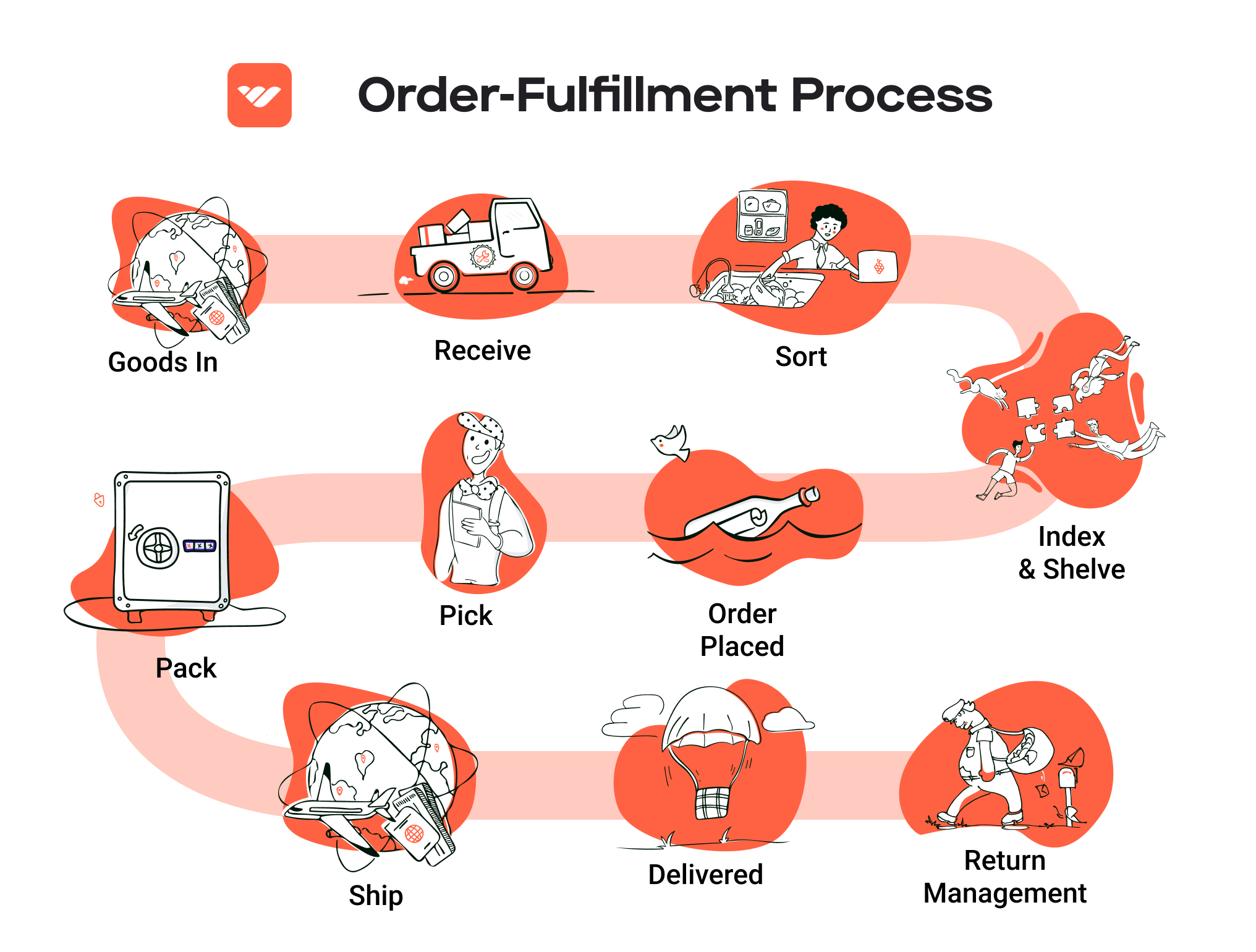
-
Customer Service and Returns: Amazon manages all customer inquiries and return processes, allowing sellers to focus on other aspects of their business.
Pros of Using FBA
1. Prime Eligibility
One of the most significant advantages of FBA is that products become eligible for Amazon Prime. This can significantly increase sales, as Prime members tend to favor Prime-eligible products due to the fast and free shipping options.
2. Enhanced Customer Trust
Amazon is a trusted brand with a well-established reputation for customer service. When you use FBA, your products are associated with Amazon’s brand, which can enhance customer confidence and increase conversion rates.
3. Multi-Channel Fulfillment
FBA allows sellers to fulfill orders not only from Amazon but also from other sales channels, such as their own websites or other e-commerce platforms. This means you can streamline your logistics by using Amazon’s fulfillment services for various sales channels, simplifying inventory management and order processing.
4. Streamlined Operations
With FBA, sellers can offload the complexities of storage, packing, shipping, and customer service, allowing them to focus on marketing and expanding their product lines.
5. Access to Amazon’s Logistics Network
Amazon’s vast logistics network allows for faster shipping times and more reliable delivery options, which can improve customer satisfaction and lead to higher sales.
Cons of Using FBA
1. High Fees
FBA comes with various fees, including storage fees and fulfillment fees. These costs can add up quickly, especially for sellers with low-margin products or those who do not maintain a high inventory turnover. It’s essential to analyze whether the benefits outweigh the costs based on your product pricing and sales volume.
2. Strict Inventory Rules
Sellers must adhere to Amazon’s strict inventory management policies, including guidelines on product labeling, packaging, and storage. Failure to comply can result in additional fees or even suspension from the program.
3. Commingling Risks
When using FBA, sellers’ products may be commingled with those of other sellers. This means that if a customer receives a defective or damaged item, it can be challenging to trace it back to the original seller. This can lead to a loss of control over product quality and customer satisfaction.
4. Limited Control Over Shipping
While Amazon handles the logistics, sellers have limited control over the shipping process. This can be a disadvantage if you want to ensure specific shipping methods or packaging.
5. Inventory Management Challenges
Managing inventory across multiple fulfillment centers can be challenging, particularly if products are slow-moving. Sellers need to monitor stock levels closely to avoid long-term storage fees and stockouts.
Who is FBA Best For?
Fulfillment by Amazon is best suited for:
-
Small to Medium-Sized Businesses: Those looking to scale quickly without investing heavily in logistics infrastructure can benefit from FBA’s streamlined processes and access to Amazon’s customer base.
-
Sellers with High Turnover Products: If your products have a high sales volume and quick turnover, the fees associated with FBA may be justified by increased sales and reduced operational burdens.
-
E-commerce Entrepreneurs: New sellers who want to focus on growing their brand rather than managing logistics will find FBA advantageous.
-
Multi-Channel Sellers: Businesses that sell on multiple platforms can simplify their fulfillment processes by using FBA for all their orders.
In conclusion, while FBA offers numerous advantages, such as increased visibility and reduced operational burdens, it also comes with challenges that require careful consideration. Sellers should evaluate their business model, product types, and overall strategy to determine if FBA aligns with their growth goals.
Core Services Offered by Fulfillment Centers
Inventory Management & Warehousing
Inventory management and warehousing are the backbone of any fulfillment center’s operations. This service involves the systematic tracking, storing, and handling of goods from the moment they arrive at the warehouse until they are shipped to customers. Fulfillment centers utilize advanced Warehouse Management Systems (WMS) to monitor inventory levels, manage stock locations, and provide real-time data on product availability.
The benefits of robust inventory management are manifold. First, it ensures that e-commerce businesses maintain optimal stock levels, preventing both overstocking and stockouts. This balance is crucial for minimizing holding costs while ensuring customer satisfaction through timely order fulfillment. Second, efficient warehousing practices, such as organized shelving and clear labeling, facilitate quicker picking processes, reducing the time it takes to prepare orders for shipment. Moreover, accurate inventory management enhances forecasting capabilities, allowing businesses to anticipate demand fluctuations and plan their procurement strategies accordingly.
Pick and Pack Services
Pick and pack services are essential in the order fulfillment process, where items are collected (“picked”) from inventory and then packaged (“packed”) for shipment to customers. This service typically involves generating a pick list through the WMS when an order is received, guiding warehouse staff to the exact locations of the items needed for each order. After picking, the items are transferred to a packing station where they are securely packaged, labeled, and prepared for shipping.
The primary advantage of pick and pack services is the speed and efficiency they bring to order fulfillment. By leveraging technology and streamlined processes, fulfillment centers can often ship orders on the same day they are received, significantly enhancing customer satisfaction. Additionally, accurate picking reduces the likelihood of fulfillment errors, which can lead to costly returns and dissatisfied customers. For e-commerce businesses, the ability to offer fast and accurate order fulfillment can be a competitive differentiator in a crowded marketplace.
Kitting and Assembly
Kitting and assembly services involve grouping individual items into a single, ready-to-ship product. This might include assembling products that require multiple components or creating gift sets and bundled offers. Fulfillment centers can handle the entire kitting process, from gathering the necessary items to packaging them together, often using specialized equipment to streamline the assembly process.
The benefits of kitting and assembly services for e-commerce businesses are significant. First, they allow for the creation of unique product offerings, which can enhance marketing strategies and attract more customers. For instance, offering a bundled product can increase average order value and improve sales. Additionally, outsourcing kitting and assembly to a fulfillment center frees up valuable time and resources for e-commerce businesses, allowing them to focus on core activities such as marketing and customer service. This service also ensures that products are assembled correctly and efficiently, reducing the potential for errors that could negatively impact customer satisfaction.
Returns Management (Reverse Logistics)
Returns management, or reverse logistics, is a critical service offered by fulfillment centers, particularly in the realm of e-commerce where return rates can be high. This service involves handling returned merchandise, processing refunds or exchanges, and managing the reintegration of returned items into inventory. Fulfillment centers typically have dedicated systems in place to efficiently manage the flow of returns, ensuring that returned items are assessed, sorted, and processed quickly.
The benefits of effective returns management are crucial for maintaining customer loyalty and minimizing losses. By streamlining the returns process, fulfillment centers can reduce the time it takes for customers to receive refunds or replacements, enhancing the overall shopping experience. Additionally, efficient returns management can help businesses recover value from returned products, whether by restocking items that are in good condition or finding alternative ways to sell or dispose of damaged goods. This capability not only helps protect profit margins but also contributes to a sustainable business model by reducing waste. For e-commerce businesses, a well-handled returns process can differentiate them from competitors, fostering a reputation for excellent customer service.
In summary, partnering with a fulfillment center that offers comprehensive services like inventory management, pick and pack, kitting and assembly, and returns management can significantly enhance an e-commerce business’s operational efficiency. By leveraging these core services, businesses can scale effectively, improve customer satisfaction, and ultimately drive growth in a competitive digital marketplace.
How to Choose a Fulfillment Partner: A 6-Point Checklist
Location & Warehouse Network
Why It Matters
The location of your fulfillment partner’s warehouses significantly impacts shipping costs and delivery times. Proximity to your customer base can lead to faster shipping, reduced costs, and improved customer satisfaction.
Questions to Ask
– Where are your warehouses located, and how do they align with my target markets?
– What is your average shipping time to major regions?
– Can you provide options for multiple warehouse locations to optimize shipping?
Technology & Integrations
Why It Matters
Robust technology and seamless integrations are essential for efficient order processing, real-time inventory management, and overall operational transparency. Your fulfillment partner should be able to integrate with your existing e-commerce platforms and provide a Warehouse Management System (WMS) that supports your operational needs.
Questions to Ask
– What technology platforms do you use for inventory management and order processing?
– How does your WMS integrate with my e-commerce platform?
– Can you provide real-time inventory updates and tracking information for my orders?
Specializations (e.g., Cold Storage, Oversized Items)
Why It Matters
Depending on the nature of your products, you may require a fulfillment partner with specific capabilities. Whether you need cold storage for perishable goods or specialized handling for oversized items, ensuring your partner has the necessary facilities and expertise is crucial for maintaining product quality.
Questions to Ask
– Do you have specialized facilities for my product type (e.g., cold storage, fragile items)?
– How do you handle inventory management for specialty products?
– Can you accommodate unique packaging or shipping requirements for my goods?
Scalability & Capacity
Why It Matters
As your business grows, your fulfillment needs will evolve. A good partner should offer scalability to accommodate fluctuating order volumes without compromising service quality. Understanding their capacity to handle increased demand is essential for long-term planning.
Questions to Ask
– What is your current capacity for handling orders, and how do you manage peak seasons?
– Can you scale operations quickly if my sales increase significantly?
– How do you handle overflow during busy periods, and what contingency plans do you have in place?
Pricing and Contracts
Why It Matters
Understanding the pricing structure and contract terms of your fulfillment partner is vital for budgeting and financial forecasting. Look for transparency in pricing and ensure there are no hidden fees that could erode your profit margins.
Questions to Ask
– What is your pricing model (per order, per item, monthly fees)?
– Are there additional fees for services such as returns processing, storage, or special handling?
– What are the terms of the contract, and what is the process for terminating or renegotiating it?
Customer Support & Reviews
Why It Matters
Reliable customer support is crucial for addressing issues quickly and ensuring smooth operations. Additionally, reviews and testimonials from current or past clients provide insights into the fulfillment partner’s reliability and service quality.
Questions to Ask
– What level of customer support do you offer (dedicated account manager, 24/7 support)?
– Can you provide references or case studies from businesses similar to mine?
– How do you handle disputes or service failures, and what is your track record for resolution?
Conclusion
Choosing the right fulfillment partner is a strategic decision that can influence your e-commerce business’s success. By using this checklist, you can evaluate potential partners comprehensively, ensuring they align with your operational needs and growth objectives. Take the time to conduct thorough research and ask the right questions to make an informed decision that supports your business’s future.
Understanding Fulfillment Pricing: A Breakdown of Common Fees
Initial Setup Fees
Initial setup fees are one-time charges associated with establishing your account with a fulfillment provider. These fees can vary widely depending on the complexity of your operations and the provider’s requirements. Typical costs may include account creation, system integration, and any necessary onboarding training.
Calculation: Providers may charge a flat fee for setup, which can range from a few hundred to several thousand dollars. In some cases, they might also assess fees based on the number of SKUs you plan to store or the complexity of your inventory management needs. It’s crucial to clarify what services are included in the setup fee to avoid unexpected costs down the line.
Receiving Fees
Receiving fees apply when your products arrive at the fulfillment center. This fee covers the labor and equipment costs associated with unloading, inspecting, and entering inventory into the warehouse management system (WMS).
Calculation: Receiving fees are typically charged per shipment or based on the volume of products received, such as per pallet or per unit. Expect to pay anywhere from $25 to $100 per shipment, depending on the provider and the size of the shipment. Some providers may offer tiered pricing where larger shipments have a lower per-unit receiving fee.
Storage Fees (per pallet/bin)
Storage fees are ongoing charges for keeping your inventory in the fulfillment center. This fee is crucial for understanding the total cost of managing your inventory, as it can significantly impact your bottom line.
Calculation: Storage fees are usually charged monthly and can be calculated on a per-pallet or per-bin basis. Rates vary depending on the provider, location, and seasonality. A common range for storage fees is between $10 and $50 per pallet per month. Some providers may also charge based on cubic footage, which can be beneficial for businesses with smaller, high-value items.
Pick & Pack Fees (per item/order)
Pick and pack fees cover the labor involved in retrieving items from storage and packaging them for shipment. This process is critical for ensuring that orders are fulfilled accurately and efficiently.
Calculation: Pick and pack fees can be assessed on a per-item or per-order basis. For example, a provider might charge $1 to $3 per item picked and packed. Alternatively, they may offer a flat fee per order, which could range from $5 to $10, regardless of the number of items included. Understanding the provider’s picking methodology—whether it’s individual or batch picking—can help you estimate these fees accurately.
Shipping Fees
Shipping fees encompass the costs associated with delivering orders to your customers. These fees can fluctuate based on several factors, including the shipping method, destination, and carrier.
Calculation: Shipping fees are calculated based on weight, dimensions, and the distance to the delivery location. Providers often have negotiated rates with carriers, which can help reduce costs. It’s essential to consider both domestic and international shipping rates, as well as any additional surcharges that may apply during peak seasons or for expedited shipping. Make sure to ask your provider about their carrier partnerships and how they calculate shipping fees to ensure you’re getting competitive rates.
Tips for Getting an Accurate Quote
-
Provide Detailed Information: When requesting a quote, be as specific as possible about your inventory, order volume, and fulfillment needs. Include information on product dimensions, weight, and anticipated shipping destinations.
-
Ask About Hidden Fees: Inquire about any additional charges that may not be included in the initial quote, such as returns processing, special handling, or inventory audits.
-
Evaluate Contract Terms: Review the terms of service carefully. Understand any minimum commitments, cancellation policies, and conditions under which fees might change.
-
Compare Multiple Providers: Obtain quotes from several fulfillment centers to compare pricing structures and services offered. This will give you a better sense of the market rates and help you make an informed decision.
-
Negotiate: Don’t hesitate to negotiate terms with potential fulfillment partners. Many providers are open to adjusting fees or offering discounts based on your business’s specific needs and volume.
By understanding these common fulfillment pricing models and following these tips, you can make more informed decisions, allowing your e-commerce business to scale effectively while managing costs.
Frequently Asked Questions (FAQs) about Fulfillment
1. What is eCommerce fulfillment?
eCommerce fulfillment refers to the entire process of receiving, storing, picking, packing, and delivering products to customers who have placed orders online. It encompasses everything from managing inventory in a warehouse to handling returns and ensuring timely delivery.
2. How do you fulfill an eCommerce order?
The order fulfillment process typically involves several steps:
1. Receiving: Products are delivered to a fulfillment center and logged into inventory.
2. Storage: Items are organized and stored in a way that facilitates efficient picking.
3. Picking: When an order is placed, items are retrieved based on a generated pick list.
4. Packing: Items are securely packed into boxes, ready for shipment.
5. Shipping: Packages are handed over to carriers for delivery to the customer.
3. What’s the difference between a warehouse and a fulfillment center?
A warehouse primarily serves as a storage facility for goods, focusing on inventory management. In contrast, a fulfillment center is specifically designed to handle the logistics of order fulfillment, including picking, packing, and shipping products to customers. Fulfillment centers often have advanced technologies and processes to streamline these operations.
4. What is a 3PL (Third-Party Logistics)?
A 3PL is a service provider that manages various logistics functions for businesses, including warehousing, fulfillment, and shipping. By outsourcing these processes to a 3PL, eCommerce businesses can leverage their expertise, infrastructure, and technology, allowing them to focus on core business activities.
5. How much do fulfillment services cost?
Fulfillment service costs vary based on several factors, including the volume of orders, the complexity of the fulfillment process, storage needs, and shipping methods. Typically, fees can include storage fees, picking and packing fees, and shipping costs. It’s essential to evaluate different fulfillment partners and their pricing structures to find the best fit for your business.
6. What are the benefits of outsourcing fulfillment?
Outsourcing fulfillment can provide numerous advantages, such as:
– Cost Savings: Reducing overhead costs related to warehousing and staffing.
– Scalability: Easily scale operations as your business grows without the need for significant investments.
– Expertise: Leverage the expertise of logistics professionals who specialize in order fulfillment.
– Focus on Core Business: Allow your team to concentrate on marketing and sales rather than logistics.
7. How can I improve my fulfillment process?
To enhance your fulfillment process, consider the following strategies:
– Invest in Technology: Utilize inventory management and order fulfillment software to streamline operations.
– Optimize Warehouse Layout: Arrange products logically to minimize picking time.
– Implement Efficient Picking Methods: Use batch picking or zone picking to speed up order fulfillment.
– Monitor Performance Metrics: Regularly analyze key performance indicators (KPIs) like order accuracy and shipping times to identify areas for improvement.
8. What role does inventory management play in fulfillment?
Effective inventory management is critical in fulfillment as it ensures that the right products are available to meet customer demand without overstocking. Proper inventory practices help prevent stockouts, reduce holding costs, and improve order fulfillment speed, ultimately enhancing customer satisfaction.
9. How do I handle returns in eCommerce fulfillment?
Handling returns effectively involves having a clear returns policy and process. Options include:
– Direct Returns to Fulfillment Center: Customers send items back to the fulfillment center for inspection and restocking.
– Refund Without Return: For low-value items, consider offering refunds without requiring customers to return products.
– Reverse Logistics Partner: Use a third-party service to manage returns efficiently, including inspecting and restocking items.
10. What are common challenges in eCommerce fulfillment?
Common challenges include:
– Inventory Management: Balancing stock levels to meet demand without overstocking.
– Shipping Delays: Ensuring timely delivery despite potential carrier issues.
– Order Accuracy: Minimizing picking and packing errors to enhance customer satisfaction.
– Returns Handling: Efficiently processing returns while managing associated costs.
By addressing these challenges proactively, businesses can streamline their fulfillment processes and improve overall performance.
Conclusion: Is Outsourcing Fulfillment the Right Move for Your Business?
Evaluating the Benefits of Outsourcing Fulfillment
Outsourcing fulfillment can be a transformative strategy for e-commerce businesses looking to scale efficiently. By leveraging a third-party logistics (3PL) provider, companies can save valuable time and resources, allowing them to focus on core business functions such as marketing, product development, and customer engagement. A fulfillment partner takes on the complexities of warehousing, inventory management, order processing, and shipping, which can significantly enhance operational efficiency.
One of the key advantages of outsourcing is scalability. As your business grows, so do the demands on your logistics operations. A reliable fulfillment service can adapt to fluctuating order volumes, ensuring that you can meet customer expectations without the burden of managing excess inventory or staffing issues during peak seasons. This flexibility allows for smoother transitions during growth phases, preventing disruptions that can harm customer satisfaction.
Additionally, partnering with a fulfillment expert brings industry knowledge and experience to the table. These providers often employ advanced technology and best practices in inventory management and shipping logistics, which can lead to improved accuracy, faster processing times, and reduced shipping costs. Their expertise can also enhance your returns management process, making it seamless for both your business and your customers.
However, the success of outsourcing fulfillment hinges on selecting the right partner. It’s essential to assess potential 3PL providers based on their capabilities, technology, and alignment with your business goals.
To determine if outsourcing fulfillment is the right move for your business, conduct a thorough audit of your current shipping and fulfillment processes. Identify pain points, inefficiencies, and areas where a dedicated partner could add value. By taking this step, you can make a well-informed decision that positions your business for sustainable growth and customer satisfaction.
Important Disclaimer
⚠️ Important Disclaimer
The information in this guide is for educational purposes. Fulfillment services, pricing, and platform features change frequently. Always conduct your own due diligence and consult with providers directly before making business decisions.
